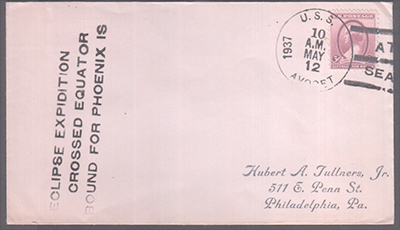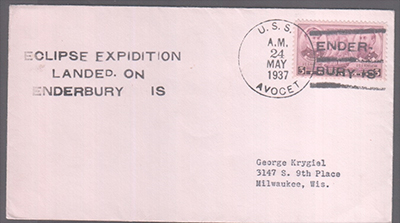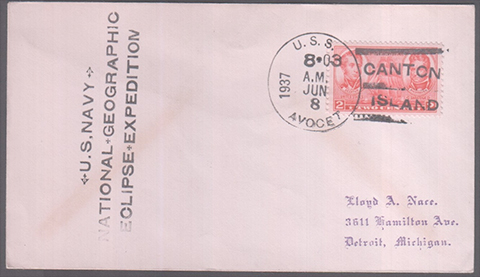Space Cover 712: June 8, 1937 Solar Eclipse For thousands of years mankind has been fascinated by celestial objects and the phenomenon of their movements, the science of astronomy. The cover above, postmarked June 8, 1937 onboard the USS Avocet, was witness at the time to the longest duration totality of any solar eclipse in the past six hundred years. The cachet applied on the Avocet is a customizable rubber stamp used throughout the expedition for additional event covers shown below.
The National Geographic Society first proposed an eclipse expedition in January of the same year and in partnership with the US Navy planned for a party of twelve, eight for the scientific program and four to handle the photography and radio broadcasting duties. S. A. Mitchell, director of the Leander McCormick Observatory led the expedition including directors of the Mount Wilson, Georgetown University and US Naval Observatories, US National Bureau of Standards, a photographer of the National Geographic Society, and George Hicks, an announcer for the National Broadcasting Company (NBC).
The USS Avocet (AM-19/AVP-4) was a Lapwing-class minesweeper commissioned September 17, 1918, and recommissioned September 8,1925 as a seaplane tender. Of note, the Avocet was later present during the Pearl Harbor attack on December 7, 1941, earning a World War II battle star for her participation in the defense of the pacific fleet.
On May 6, 1937, the expedition departed Hawaii for the Phoenix Islands, a group of eight atolls and two submerged coral reefs lying east of the Gilbert Islands in the central Pacific Ocean, north of Samoa.

The above cover commemorates the Avocet's crossing of the equator on May 12.

The above cover was postmarked on the morning of May 24, at Enderbury Island as the expedition approached its desired primary landing location. Enderbury was initially selected as the duration of totality was 30 seconds longer owing to the island's position closer to the center of the Moon's shadow path. Unfortunately, upon arrival no suitable anchorage was found, with the water close to shore being more than 600 feet in depth.
It was determined to proceed to Canton Island, which is shaped like an inverted letter C, having a narrow strip of coral around a lagoon, trade winds and tidal currents would keep the Avocet offshore in case the anchor was dragged with no steam in the boilers. Using 10,000 feet of lumber and 60 bags of cement a wharf was constructed, necessary to offload the 150 cases of scientific equipment. The instruments were arranged close to the edge of the lagoon and the most important building of the expedition were the darkrooms which contained a spectrograph, a duplicate of one used on the 100-inch reflector of Mount Wilson Observatory.
On May 26, H.M.S. Wellington arrived at Canton Island, bringing a party of eight from New Zealand. Covers from the Wellington exist on the day of the eclipse, typically having a map cachet, and possess postmarks identical to those of the Avocet as all mail was brought aboard for cancellation.
On eclipse day, June 8, preparations began before dawn including many that had been up all night in last-minute calibration of instrumentation. The radio broadcast started at 5:30am, with Sunrise about 7am. The team experienced great luck with clear skies throughout the duration of the eclipse, totality occurred at 8:36am.

The corona was described by expedition director Mitchell as "the most beautiful I had ever seen in all of my ten total eclipses." There was a broadcast telling of the dramatic event with George Hicks of NBC on the roof of the darkroom, describing to the listening world the gradual coming of darkness... toward the end of the broadcast he said, "We are all as happy as clams."
The expedition lasted 42 days and the most typical set of covers consists of three pictured within this article (1. Crossing the Equator, 2. Landing on Enderbury Island, 3. Eclipse on Canton Island).
As a final note, astronauts have participated directly in at least two other eclipse viewings with Scott Carpenter flying aboard a DC-8 tracking the path on July 20th, 1963 and Neil Armstrong aboard the P&O Cruise Ship "The Canberra" on June 30th, 1973.
Do you have a favorite eclipse event or cover?
















